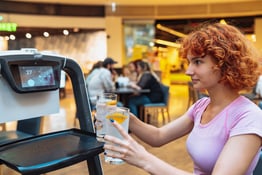A busy restaurant is a happy restaurant. Not so slammed that nerves fray and mistakes creep into the kitchen. But definitely bustling, in rhythm. Cooks break a sweat, maybe even crack a joke. Bartenders are flipping bottles and pulling tap handles. Servers are in motion. Managers are trouble-shooting in real time. And the front and back of house both sense the time passing quickly, knowing that everyone is doing good work, supporting one another, and leaving with a wad of cash in their pocket.
It’s a great feeling, and one that restaurant operators constantly strive for: the sensation that comes when money is coming in and all boats are being lifted. Shy of literally selling your kitchen equipment, there are only two sure ways to nudge your profits higher. You’ve either got to cut costs (which is less fun) or goose sales (which is fun as all get-out).
There’s only so much that the latest restaurant technology alone can do to ramp up your sales — and we’ll definitely get to that. In many ways the tried-and-true tenets of hospitality remain the go-tos. But many of the familiar premises that restaurants have honed over eons now have some slick software solutions to help them get the job done.
When you want to see healthier sales at your place, here’s where to start.
Tell more people about your restaurant
There’s an art and a science to expanding your customer base. If you want to lean into the art, you can stir up word-of-mouth for free (or for relatively cheap) on social media. Yes, it can take over your entire day, if you let it. But your customers live on Facebook and Instagram — and if you’re aiming to attract younger folks in particular, you can find them on restaurant TikTok. Exploring ways to spread news, offer specials, or simply have fun on those platforms is de rigueur these days for restaurant operators. Find the funniest people you have on staff who won’t drop any more f-bombs than absolutely necessary, press record, and go to town.
As for the science, it can get very scientific indeed. They have their drawbacks, of course (fees being the most notorious) but third-party restaurant delivery apps are a sure way to get your restaurant in front of a giant audience in a hurry. More than 100 million Americans have a delivery app on their phone right now, an absolutely preposterous number, and younger Americans in particular are apt to use them. That volume doesn’t always translate into bigger profits if you can’t keep menu prices ahead of the fees — to the point that some places decide to start their own delivery services instead. But when your goal is simply to get the word out, the apps are a tsunami.
Get more customers in and out
Oh, wow, so now more folks know about your restaurant. There are … hungry people waiting outside, even? Huh. This falls under good problems to have. But even those are problems, if you don’t get them sorted. You've got to keep people moving through the place quicker. Just, not so quickly they don't enjoy themselves.
There are some deeper psychological tacks that restaurateurs have tried since the dawn of time to turn over tables. Ever wonder why seemingly every fast food restaurant has some variation of red and yellow in its color scheme? Those are upbeat colors, to subtly signal people to keep moving. Other places will play fast music, or loud music, or both, to imbue the room with a sense of (presumably healthy) anxiety, to the point that many restaurants are simply too loud.
You don’t need to get that devious. The simplest first step to doing higher numbers when you’ve got a limited number of seats is to seat, feed, and bill customers without a bunch of dead time. An easy way to do that without changing anything else about your atmosphere is to use a mobile payment system, so your servers do fewer laps to and from a credit card machine.
Quicker table turnover became a particularly big deal during Covid, when restaurants had to limit available seating. The basic principles stand, though, pandemic or not. And they don't need to be complicated. Even a server asking offhandedly where you’re heading next can be a low-key signal to people to start making room for the next person in line.
Diversify your revenue streams
A fancy way of saying “find new ways to make money.” If you’re not offering delivery, that's an immediate place to start. Use an e-commerce platform to sell merch, ship meals outside your city, or let people book special occasions. During the pandemic, when bars and restaurants were scrambling for any sort of revenue, many of them sold dry goods right up to and including toilet paper, like a general store. Get creative.
But you don’t need to get too out-there. You could do something as simple as offer private dining, especially to customers you want to impress with exclusive-seeming service. And many kitchens these days are supplementing their income by working for multiple brands. A “virtual” restaurant brand might pay you to prepare and deliver its food from your kitchen, or pay to use your kitchen during hours when you’re closed. Customers don’t know where their delivery meals are prepared, ultimately, which opens up new opportunities for kitchens to be more promiscuous.
Use data to optimize your menu
The menu is even more important than ever these days, when so many people rely solely on delivery. People aren’t coming for the ambience of your amazing patio when they’re getting meals from your brown paper sack. So every item has to pull its weight both inside your restaurant and outside. Make sure you’re taking advantage of the wealth of data that restaurants now have about food costs, waste streams, customers’ ordering habits, and your profit margins on every item. See what you can drop from the menu — and what people might even pay a little more for.
Turn customers into regulars
So you got them in the door. Nearly as important, you got them out of the door. You got them to spend a nice chunk of money. Now, how do you get them back? The classic technique of looking a person in the eye, saying thank you, and letting them know you look forward to seeing them again is a fine one. Perhaps better these days is keeping in touch with email, texts, or social media.
Restaurant customers generate a huge data footprint when they spend money, and the best way to keep track of that data is through a software called a CRM, short for “customer relationship management.” There’s an excellent chance your POS includes a CRM to help you glean usable insights from the data your customers divulge when they swipe their credit card at your bar or place an order online. Those will help you offer small touches — a discount on someone’s birthday, a reminder email when you launch new specials or menu items — that let you hold customers’ attention beyond a single meal. Once you scale up a bit, you might even start eyeing a dedicated customer data platform to keep track of what you know about your customers.
Also, you should start a loyalty program. People love ‘em. If you think they’re cheesy, well, make up one that isn’t, and offer that.
Build an amazing staff
Look, facts is facts, if your staff hates life, your customers aren’t going to want to stick around for that $9 tiramisu after the dinner plates are cleared. If you want the most people coming in, and spending the most money, you should make a point of hiring the best people and keeping them happy. Easier said than done, especially in the days of restaurants struggling to retain any of their workers, let alone their best. When people quit and leave stations uncovered, that’s a recipe to burn out the rest of your staff.
So stick to the basics. Start by hiring people who are a good cultural fit, who are eager to join your crew, and whatever you do, when you identify those job candidates, snap them up in a hurry. Train your staff in the fundamentals of strong hospitality and, if increasing sales is the main goal, in upselling drinks, desserts, and appetizers. And then do your best to make those people feel seen, appreciated, and provided for. Employees enjoy benefits, they enjoy time off, they enjoy knowing their schedules well in advance, and they enjoy being paid well. Keep driving sales higher, and with any luck that last bit will be the easy part.
[Photo by Priscilla Du Preez on Unsplash]





